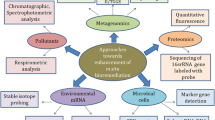Abstract
Microbial cultures able to degrade xenobiotic compounds are the key element for biological treatment of waste effluents and are obtained from enrichment processes. In this study, two common enrichment methods, suspension batch and immobilized continuous, were compared. The main selection factor was the presence of 1,3-dichloro-2-propanol (1,3-DCP) as the single carbon source. Both methods have successfully enriched microbial consortia able to degrade 1,3-DCP. When tested in batch culture, the degradation rates of 1,3-DCP by the two consortia were different, with the consortia obtained by batch enrichment presenting slightly higher rates. A preliminary morphological and biochemical analysis of the predominant colonial types present in each degrading consortia revealed the presence of different constituting strains. Three bacterial isolates capable of degrading 1,3-DCP as single strains were obtained from the batch enrichments. These strains were classified by 16S rRNA analysis as belonging to the Rhizobiaceae group. Degradation rates of 1,3-DCP were lower when single species were used, reaching 45 mg l-1 d-1, as compared to 74 mg l-1 d-1 of the consortia enriched on the batch method. Mutualistic interactions may explain the better performance of the enriched consortia.
Similar content being viewed by others
References
Altschul, SF, Madden TL, Schäffer AA, Zhang J, Zhang Z, Miller W & Lipman DJ (1997) Gapped BLAST and PSI-BLAST: a new generation of protein database search programs. Nucleic Acids Res. 25: 3389-3402
Arcangeli J-P & Arvin E (1995) Biodegradation rates of aromatic contaminants in biofilm reactors. Water Sci. Technol. 31: 117-128
Armfield SJ, Sallis PJ, Baker PB, Bull AT & Hardman DJ (1995) Biodegradation of haloalkanes by Rhodococcus erythropolis Y2: the presence of an oxygenase-type dehalogenase complemens a halidohydrolase activity. Biodegradation 6: 237-246
Assis HMS, Sallis PJ, Bull AT & Hardman DJ (1998) Biochemical characterisation of a haloalcohol dehalogenase from Arthrobacter erithii H10a. Enzyme Microb. Technol. 22: 568-574
Atlas RM & Bartha R (1997) Interactions among microbial populations. In: Atlas RM & Bartha R (Eds) Microbial Ecology, Fundamentals and Aplications, 4th edition (pp59-93). Benjamin/ Cummings Science Publishing, London
Bull AT & Slatter JH (1982) Historical perspectives on mixed cultures and microbial communities. In: Bull AT & Slatter JH (Eds) Microbial Interactions and Communities, Vol 1 (pp 1-44). Academic Press, London
Bull AT, Hardman DJ, Sallis PJ & Stubbs BM (1992) Dehalogenation of organohalogen-containing compounds. U.S. patent P10504.S01
Christiansen K, Nielsen BB, Doelman P & Schelleman F (1995) Cleaner technologies in Europe. J. Cleaner Prod. 3: 62-70
Eckenfelder W (1995) Biological treatability studies: New regulations require a new approach. Environ. Prog. 14: 172-175
Effendi AJ, Greenaway SD & Dancer BN (2000) Isolation and characterization of 2,3-dichloro-1-propanol-degrading rhizobia. Appl. Environ. Microbiol. 66: 2882-2887
Fauzi AM, Hardman DJ & Bull AT (1996) Biodehalogenation of low concentrations of 1,3-dichloropropanol by mono-and mixed cultures of bacteria. Appl. Microbiol. Biotechnol. 46: 660-666
Felsenstein J (1995) Phylogeny inference package, version 3.57c. University of Washington Seattle
Hall TA (1999) BioEdit: a user-friendly biological sequence alignment editor and analysis program for Windows 95/98/NT. Nucl. Acids Symp. Ser. 41: 95-98
Iwasaky I, Utsumi S, Hagino K & Ozawa T (1956) A new spectrophotometric method for the determination of small amounts of chloride using the mercury thiocyanate method. J. Chem. Soc. Jap. 29: 860-864
Klecka GM, McDaniel SG, Wilson PS, Carpenter CL, Clarck JE, Thomas A & Spain JC (1996) Field-evaluation of a granular activated carbon fluid-bed bioreactor for treatment of chlorobenzene in groundwater. Environ. Prog. 15: 93-107
Lane DJ (1991) 16S/23S rRNA sequencing. In: Stackebrandt E & Goodfellow M (Eds) Nucleic Acid Techniques in Bacterial Systematics (pp 115-175). Wiley, Chichester, UK
Livingston AG, Arcangeli, J-P, Boam AT, Zhang S, Marangon M & Freitas dos Santos LM (1998) Extractive membrane bioreactors for detoxification of chemical industry wastes: process development. J. Memb. Sci. 151: 29-44
Nakamura T, Nagasawa T, Yu F, Watanabe I & Yamada H (1992) Resolution and some properties of enzyme involved in enantioselective transformation of 1,3-dichloro-2-propanol to (R)-3-chloro-1,2-propanediol by Corynebacterium sp. strain N-1074. J. Bacteriol. 174: 7613-7619
Omura M, Hirata M, Zhao M, Tanaka A & Inoue N (1995) Comparative testicular toxicities of two isomers of dichloropropanol, 2,3-dichloro-1-propanol, and 1,3-dichloro-2-propanol, and their metabolites alpha-chlorohydrin and epichlorohydrin, and the potent testicular toxicant 1,2-dibromo-3-chloropropane. Bull Environ. Contam. Toxicol. 55: 1-7
Splendiani A, Moreira de Sá JAGC, Jorge R, Nicolella C & Livingston AG (2000) Development of an extractive membrane bioreactor for degradation of 3-chloro-4-methylaniline in an industrially produced wastewater: from bench to pilot scale. Environ. Prog. 45: 725-732
Steele DB & Stowers MD (1991) Techniques for selection of industrially important microorganisms. Annu. Rev. Microbiol. 45: 89-106
van den Wijngaard AJ, Janssen DB & Witholt B (1989) Degradation of epichlorohydrin and halohydrins by bacterial cultures isolated from freshwater sediment. J. Gen. Microbiol. 135: 2199-2208
van den Wijngaard AJ, W ind RD & Janssen DB (1993) Kinetics of bacterial growth on chlorinated aliphatic compounds. Appl. Environ. Microbiol. 59: 2041-2048
Author information
Authors and Affiliations
Rights and permissions
About this article
Cite this article
Bastos, F., Bessa, J., Pacheco, C.C. et al. Enrichment of microbial cultures able to degrade1,3-dichloro-2-propanol: A comparison between batch and continuous methods. Biodegradation 13, 211–220 (2002). https://doi.org/10.1023/A:1020834603785
Issue Date:
DOI: https://doi.org/10.1023/A:1020834603785




